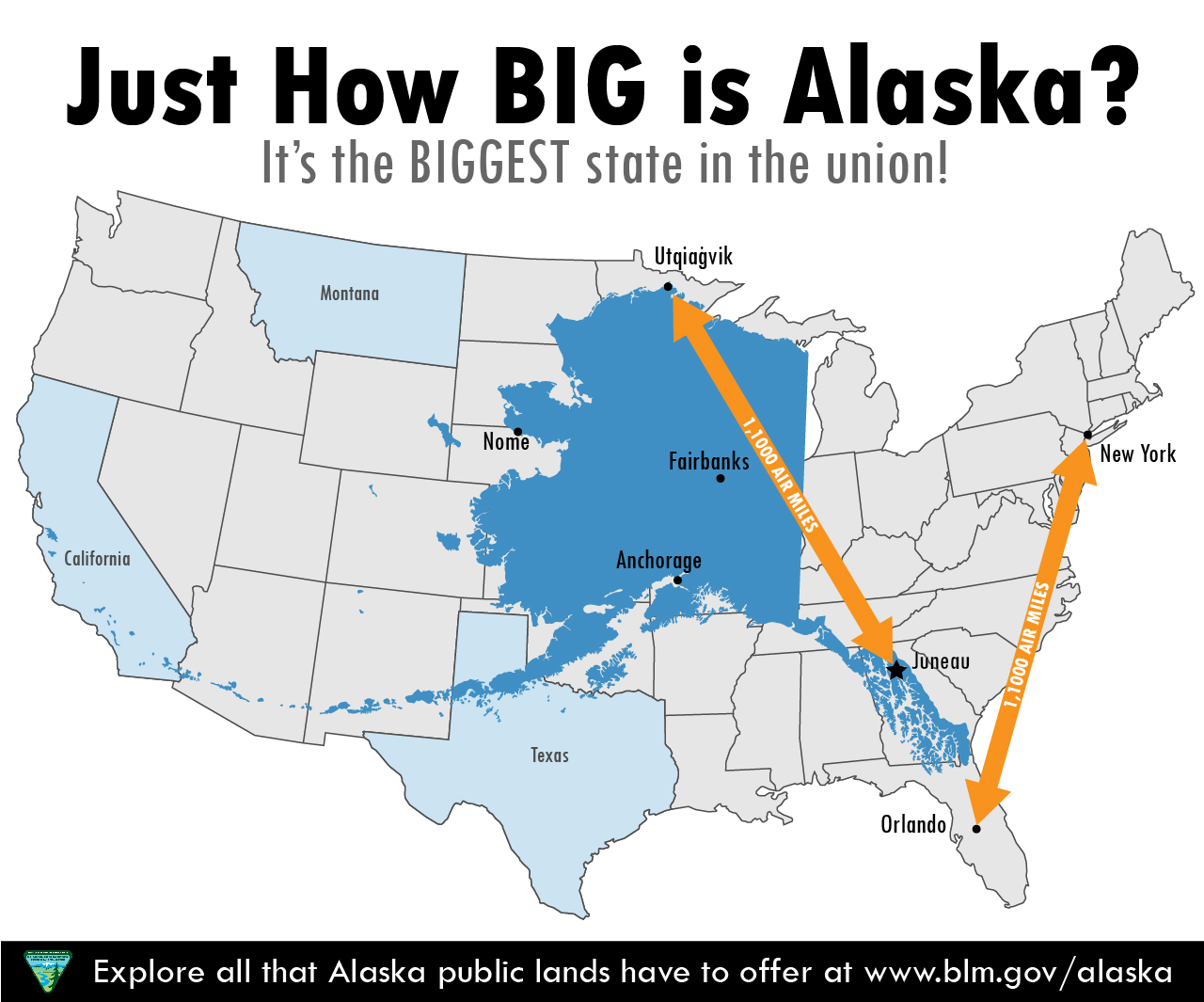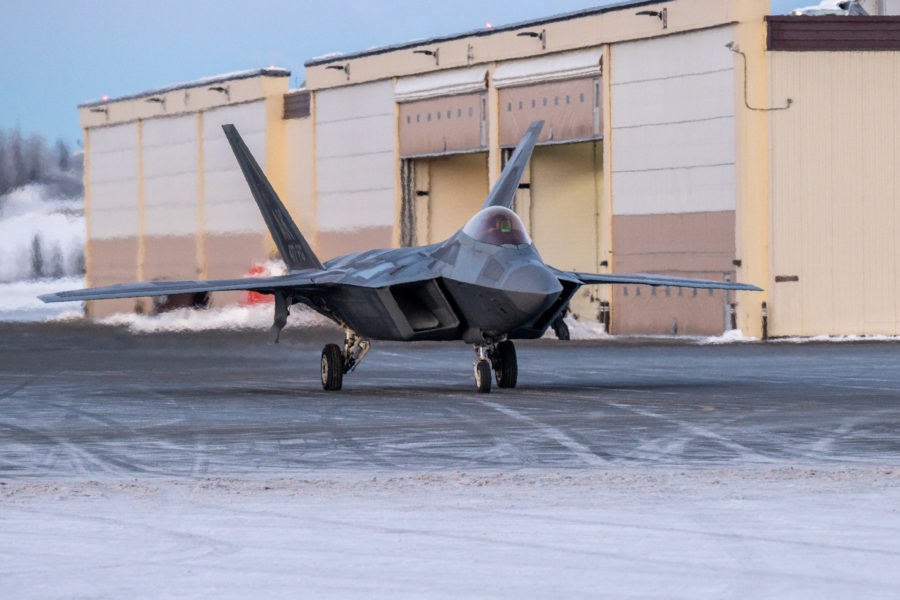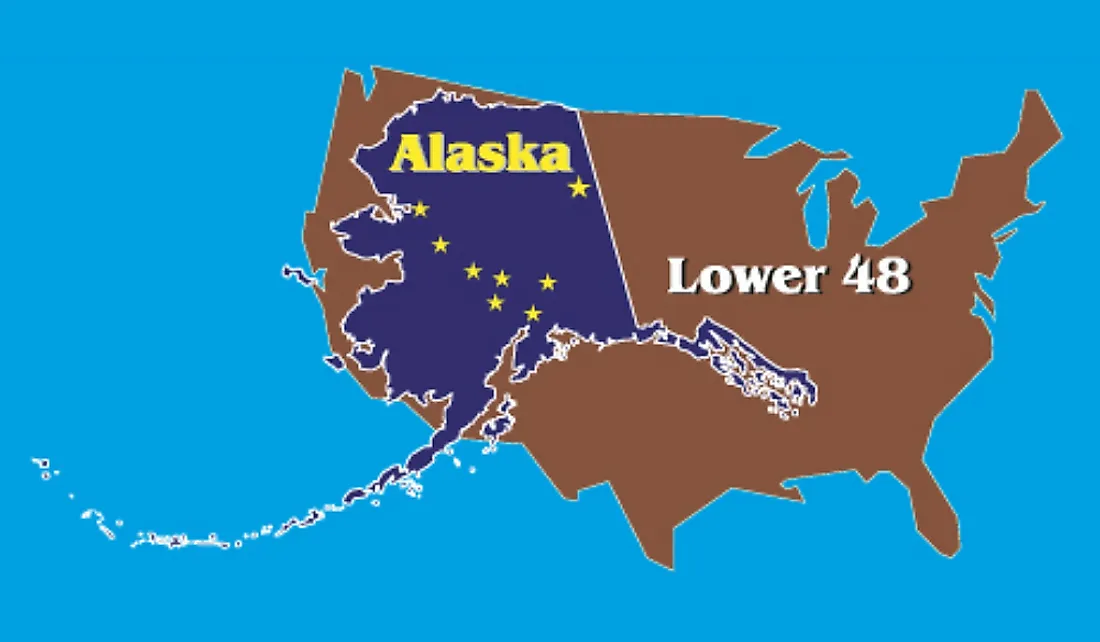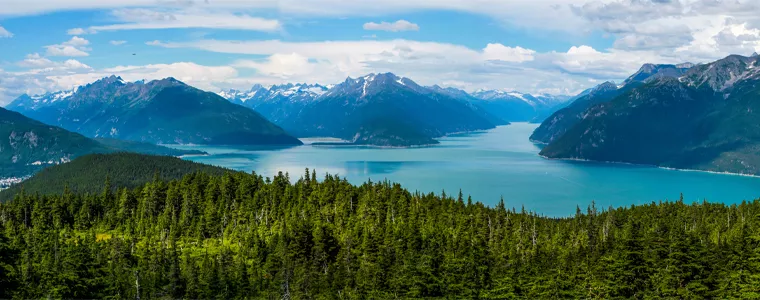Alaska, the largest state in the United States, is known for its vast wilderness, stunning natural landscapes, and unique wildlife. However, understanding just how big Alaska really is can be difficult without context.
In this article, we’ll explore some exciting comparisons that put the immense size of Alaska into perspective.
From comparing it to other U.S. states or even entire countries, let’s get ready to be amazed and gain a newfound appreciation for just how massive this incredible state truly is.

Table of Contents
1. Alaska: The Largest State in the US
Alaska, the largest state in the US, has a land area of 1,518,776 square kilometers, equivalent to one-fifth of the rest of the states and more than twice the size of Texas. The state’s vast size makes it a point of comparison when discussing landmasses across the US, and even with other countries.
Comparisons of Alaska’s size to other US states show that it is significantly larger than the state with the second-highest land area, Texas, which measures at 696,241 square kilometers. It is also more than three times the size of California and more than four times the size of Montana.
Interestingly, Alaska’s territorial waters extend beyond its land borders, making it even larger than just its land area. The state’s coastline spans over 34,000 miles, and its oceanic territories are larger than the combined landmass of the next three largest states: Texas, California, and Montana.
When considering population, however, Alaska falls behind many other states. A comparison of population sizes shows that Alaska is the fourth least populous state, with only Wyoming, Vermont, and North Dakota having fewer inhabitants.
Looking beyond the US, Alaska’s size is also significant. It is bigger than 179 United Nations-recognized countries and larger than 15 countries in the world combined.
Despite its enormous landmass, Alaska’s economy is relatively modest, with tourism and natural resource extraction being significant contributors. Nevertheless, its size and natural beauty make it a crucial spot for scientific study and conservation efforts.
As a clear contrast, the blog will also mention the economy of California, a leader among US states. This will provide readers with a comparative perspective on how the US’ largest state compares to one with a booming economy.
Finally, it is also worth noting that the White House confirmed an object was dropped over Alaska, raising questions about the state’s independence and defense capabilities. Alaska’s size in terms of airspace and altitude comparisons to balloons will also be covered in the blog.
:no_upscale()/cdn.vox-cdn.com/uploads/chorus_asset/file/3639788/Alaska-California.0.jpg)
2. Alaska vs. Other US States: A Comparison of Size
When it comes to size, Alaska truly stands out among the other US states. With an area of 1,717,856 square kilometers, it is more than twice the size of Texas, the second-largest state in the country. Its massive size is highlighted by the fact that it covers one-fifth of the entire United States.
When comparing Alaska’s size to the other states, it is clear that they simply don’t measure up. For example, California, the state with the largest economy in the US, is just over half the size of Alaska with an area of 424,000 square kilometers. Similarly, the largest east coast state, Florida, has an area of just over 170,000 square kilometers, which seems minuscule in comparison to Alaska’s size.
Moreover, Alaska’s size is not just limited to its land area. Its territorial waters extend 200 nautical miles from the coastline, allowing for an additional 2.5 million square kilometers of oceanic space belonging to the state.
Despite its massive size, Alaska’s population is relatively small compared to other states. In fact, it is the least populated state in the country, with just over 730,000 residents. For comparison, California, Texas, and Florida each have populations of over 20 million people.
When comparing Alaska to other Pacific states, it is clear that it stands out not just in size, but also in its distinctiveness. Its location and climate make it a unique destination for adventure and exploration, while its natural beauty is unparalleled in the contiguous United States.
As for its size compared to other countries, Alaska is bigger than 179 UN-recognized countries, including France, Spain, and Germany. Only 15 countries in the world are larger than Alaska, further highlighting its massive size and importance.
Overall, when it comes to size, Alaska truly stands out among the other states and countries in the world. Its vast wilderness and unique offerings make it a true gem in the United States.

3. Territorial Waters and Alaska’s Size: A Surprising Fact
Alaska’s massive size of 1,717,856 square kilometers is well known, but what many people may not realize is the impact of the state’s territorial waters on its overall size. Alaska’s coastline stretches over 34,000 miles, making it the state with the longest coastline in the US. But it’s not just the length that’s impressive.
Alaska’s territorial waters extend three nautical miles from its coastline, making its total area around 2.68 million square kilometers. To put that into perspective, that’s larger than the entire land area of India or Argentina. In fact, if Alaska were a country, its size would rank it as the 18th largest in the world.
This surprising fact puts Alaska in a unique position with regard to the management of its natural resources. The state has jurisdiction over its territorial waters, which means it has the authority to regulate activities such as fishing, oil drilling, and transportation in those areas.
Alaska’s size and the complexity of its ocean ecosystem require careful management and conservation efforts. The state is home to abundant marine life, including whales, sea otters, and several species of fish. The management of Alaska’s territorial waters is a critical concern for the state’s economy and environment.
As Alaska continues to face challenges such as climate change and increasing human activity in its waters, the importance of sustainable management practices cannot be overstated. The state’s size and unique status as a coastal region underscore the need for responsible stewardship of its natural resources.
As we continue to explore Alaska’s incredible size and unique characteristics, we are reminded of the importance of environmental protection and conservation efforts for the benefit of both present and future generations.
4. The Population of Alaska: A Comparison to Other States
According to the latest census, Alaska’s population stands at just over 731,000, making it the 48th most populous state in the United States. Despite its immense size, Alaska’s population density is among the lowest in the country, with just over one person per square mile.
Compared to other states such as California, which has a population of over 39 million, or Texas, which has a population of over 29 million, Alaska’s population is relatively small. However, it is worth noting that Alaska’s population has been steadily growing over the years, thanks in part to a strong job market in industries such as oil, mining, and fishing.
When compared to other sparsely populated states in the US, such as Montana or Wyoming, Alaska’s population is roughly on par. However, Alaska’s demographics are unique in that it has a significant Native population, with over 15% of its population identifying as Alaska Native or American Indian.
Despite its small population, Alaska’s size and natural resources make it an important player in the US economy. Its vast wilderness areas, abundant wildlife, and natural beauty continue to attract visitors from all over the world.
Overall, while Alaska may not have the same population numbers as other states, its unique demographics and economic potential make it a valuable part of the United States.

5. Alaska vs. Other Pacific States: How It Compares
In terms of size, Alaska is unmatched by any other Pacific state in the United States. It covers an area of 1,518,776 square kilometers, which is more than twice the size of Texas, the second-largest state in the US. Other Pacific states, such as Hawaii and California, are dwarfed by the sheer size of Alaska.
Hawaii, the only other state within the Pacific region that is not attached to North America, has a total area of just 28,311 square kilometers. California, which is known for its coastal beauty and lush forests, has an area of 423,970 square kilometers. These numbers pale in comparison to Alaska’s massive landmass.
Even when compared to the entire Pacific region, Alaska reigns supreme. It is one of the five states within the region, which covers a vast area of the United States. The other states in the region are Hawaii, California, Oregon, and Washington.
The sheer size of Alaska presents unique challenges and opportunities for its inhabitants. Its economy is heavily dependent on the natural resources found in its vast wilderness, such as oil, timber, and fish. The state’s population density is also low, which means that certain services and amenities may be harder to come by for those living in more remote areas.
Despite these challenges, Alaska’s size also presents opportunities for adventure and exploration. With such a vast wilderness to explore, residents and visitors alike have plenty of opportunities to experience the great outdoors.
In summary, Alaska’s size sets it apart from other Pacific states in the US. Its massive landmass dwarfs other states within the region and presents both opportunities and challenges for its inhabitants.
:no_upscale()/cdn.vox-cdn.com/uploads/chorus_asset/file/3639754/Alaska-Compare-main.0.jpg)
6. The Economy of California: A Leader Among US States Compared To Alaska
California’s economy is a major leader among US states and even ranks among the top 10 largest economies in the world. With a GDP of 1.9 trillion as of 2010, California’s economy is larger than many countries. The state’s workforce is also substantial, with 34 million people employed in various industries. This far surpasses the number of employed individuals in the entire state of Rhode Island, with only 1 million.
Compared to other states, California’s economy outperforms many. In fact, it contributed to 16 percent of job growth in the country between 2010 and 2020. This shows the prominent role California’s economy plays in the overall prosperity of the United States.
While California may have a strong economy, other states in the US also have their own strengths. Alaska, for example, boasts significant size and resources. It is the largest state in the US, with territorial waters that extend over 3 million square miles. This is larger than the entire land area of Texas! Additionally, Alaska’s size is even larger than 179 UN-recognized countries.
Despite their differences, both California and Alaska play important roles in the US economy and have unique strengths to offer. As the US economy faces external shocks and changes, it will be important for each state to leverage its strengths and work collaboratively to drive growth and prosperity.

7. The White House Confirms Object Dropped Over Alaska
In a surprising turn of events, the White House has confirmed that an unknown object was dropped over Alaska. The nature and origin of the object remain unknown at this time. The incident has sparked numerous speculations and conspiracy theories on social media.
The Alaska National Guard reported that the object was dropped near the town of Selawik, but they have not disclosed any further details. Local authorities are urging residents to remain calm and vigilant.
The Federal Aviation Administration (FAA) has launched an investigation into the incident, and the National Transportation Safety Board (NTSB) has also been alerted. The FAA has issued an air traffic alert, warning pilots to avoid the area.
The incident has raised concerns among Alaskans about potential security threats and the safety of their communities. Some residents have expressed frustration over the lack of information provided by official sources.
This latest development further highlights Alaska’s unique position as a remote but strategically important state. Its vast territory, harsh climate, and proximity to Russia have made it a subject of geopolitical and military interests.
As the investigation continues, Alaskans are hoping for answers and reassurance from their government and law enforcement agencies. The incident serves as a reminder of the challenges and opportunities of living in the Last Frontier.

8. Flying in Alaska: Altitude Comparison to Balloons
Alaska, with its vast expanse of land and coastline, is a prime location for flying activities of all kinds. However, recent events have drawn attention to the potential dangers of flying at high altitudes over the state. A few weeks ago, a high-altitude balloon from China entered US airspace over Alaska, prompting US officials to shoot it down.
This incident highlights the importance of understanding the altitude at which different types of aircraft operate. Hot air balloons, for example, are usually small in size and equipped with flight altitudes located within the stratosphere, with a height range of up to 75,000 feet. In contrast, commercial jetliners typically fly at altitudes of around 35,000 feet, while military jets like the F-22 fighter jet that shot down the balloon fly at even higher altitudes.
To put this into perspective, the size of the object that dropped off the coast of Alaska and was shot down by the US military was comparable to that of a car. This pales in comparison to the risks involved in flying commercial aircraft, which carry hundreds of passengers and fly at high speeds.
Despite this, it is important for pilots and aviation enthusiasts to be aware of the risks associated with flying at high altitudes. This includes understanding the potential dangers of weather conditions, as well as the impact of altitude on the human body. In the case of high-altitude balloons, it is also important to ensure proper communication and coordination with air traffic control to avoid any potential conflicts with other aircraft.
While the incident with the Chinese balloon highlights the need for caution in Alaska’s airspace, it is important to remember that the state’s vast size and unique geography also offer unparalleled opportunities for aviation enthusiasts. Whether exploring the rugged wilderness by bush plane or catching a glimpse of the Northern Lights from a hot air balloon, Alaska’s skies are full of possibilities for those who take the time to understand and respect the challenges of flying at different altitudes.

9. Alaska: Bigger Than 179 UN-Recognized Countries
According to the data, Alaska is not only the largest state in the US, but it is also bigger than 179 UN-recognized countries. This is a surprising fact considering that Alaska is often overlooked in discussions of global geography.
Comparing its size to other countries, only 15 are larger than Alaska. The sheer magnitude of Alaska’s landmass is astounding. To put it in perspective, Alaska is about twice the size of the second-largest US state, Texas.
This information highlights the importance of recognizing the unique characteristics and contributions of each state in the US, as well as the diversity and complexity of the global community.
As previously mentioned, Alaska also has a vast territorial waters area, further adding to its overall size. Despite its vastness, Alaska’s population is relatively small compared to other US states.
As the blog has also discussed, various scientific conferences have taken place in Alaska, reflecting a growing interest in the state’s research and development potential.
Whether it is exploring the abundance of natural resources or its potential as a hub for scientific discovery, Alaska’s size, and unique features make it an important part of the US and the global community.

10. Alaska’s Size Compared to Other Countries: Only 15 Are Bigger
Alaska’s size is not just impressive compared to other US states, but also when compared to other countries. In fact, Alaska is larger than 179 of the UN-recognized countries in the world. When comparing Alaska’s land area of 1,518,776 square kilometers to other countries, only 15 of them are bigger.
Notably, Brazil is five times larger than Alaska, but Alaska’s land area is still larger than Brazil’s on the map due to its unique shape. Scandinavia may appear larger than India on the map, but India’s land area is almost three times bigger than Alaska’s.
Alaska’s vast size makes it an important location for various industries, especially with regard to its natural resources. Its position as one of the world’s largest oil producers is due in part to its vast land area and ability to hold vast oil reserves. Alaska’s size also plays a crucial role in its tourism industry, as visitors flock to the state to experience its wilderness and natural beauty.
Overall, Alaska’s impressive size continues to grab the attention of people around the world, solidifying its place as one of the most unique and awe-inspiring locations on the planet.
Alaska Texas Size Comparison
Alaska, the largest state in the United States of America, has always held a unique place in the American imagination. Its massive size alone sets it apart, with an area equivalent to one-fifth of the rest of the states, and slightly more than twice the size of Texas.
This size comparison between Alaska and Texas has been a source of humor and amazement for decades, with Alaskans often teasing Texans by saying, “if you cut Alaska in half, Texas would be the third largest state in the Union”. While this may just be a joke, the truth behind it is staggering. Texas is indeed the second largest US state, after Alaska, with an area of 268,820 square kilometers (696,200 sq km). However, this pales in comparison to Alaska’s massive 1,518,776 square kilometers of land.
When considering territorial waters, the size difference between Alaska and other states becomes even more pronounced. Alaska is larger than the sum of the area of the next three largest states: Texas, California, and Montana. With an area of 1,717,856 square kilometers, Alaska is more than twice the size of the second largest US state, which is Texas.
– How Does Alaska’s Size Compare to Texas?
Alaska is the largest state in the United States, making it significantly larger than Texas. When comparing the two states in terms of land area, Alaska is roughly two and a half times larger than Texas. Therefore, Alaska’s size is considered to be much greater than Texas’ size in terms of land area.
Interestingly, despite its massive size, Alaska’s state capital, Juneau, has no access road. This quirk is just one of the many unique aspects of the state.
While Alaska’s size may be impressive, California leads the rest of the states in terms of the size of its economy and its gross domestic product, which last year amounted to 2.97 trillion dollars.
Overall, the size comparison between Alaska and Texas is a fascinating topic, one that highlights the sheer magnitude of the natural resources and beauty that Alaska possesses.